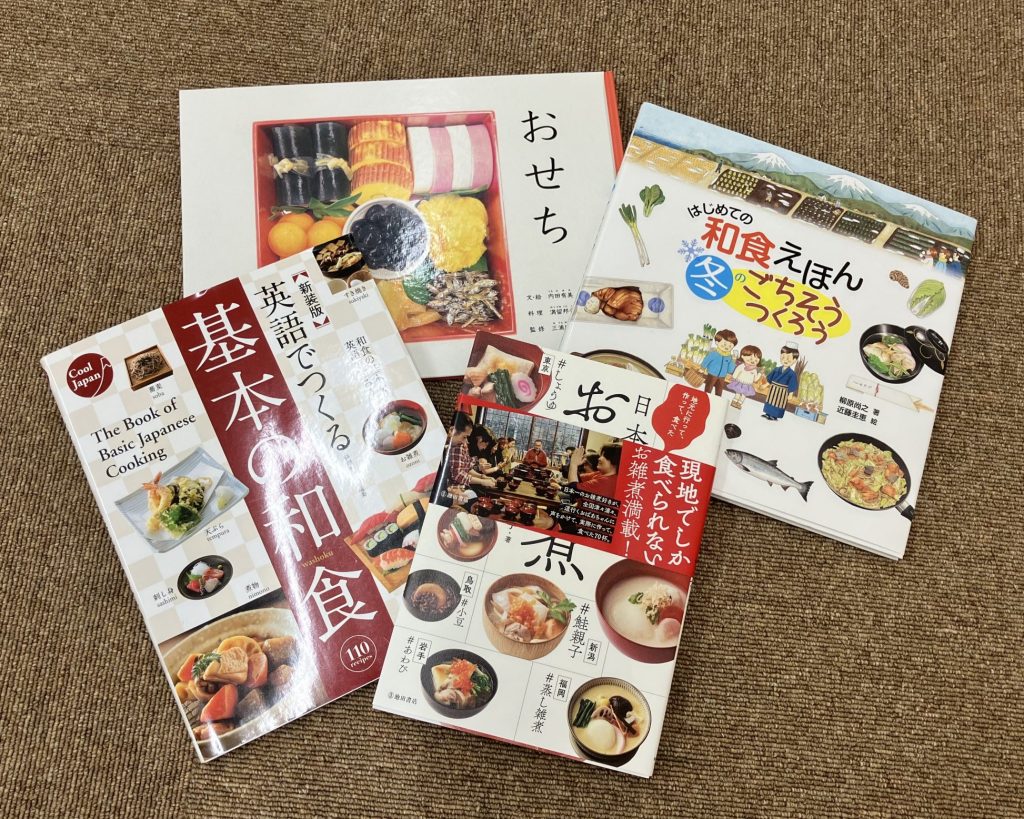
The 2025 Japanese lessons started with a week focused on learning about New Year traditions. During the annual holiday joint childcare, we experienced “Let’s Play New Year” through picture books, traditional games, and cooking. Today’s Japanese lesson delved into Washoku (traditional Japanese cuisine), which is recognized as a UNESCO Intangible Cultural Heritage.
① Ozoni (New Year’s Soup)
💡 Ozoni has been enjoyed since the Heian period. For the Japanese, rice cakes (mochi) symbolize auspicious foods eaten on special occasions. It is said that the tradition began with using water drawn early in the new year (called wakamizu), last year’s harvested vegetables, and the first fire of the year to make a soup consumed on New Year’s Day. The word ozoni originates from nimaze (mixing various ingredients).
Flipping through the pages of “Ozoni Recipes from All Over Japan,” the excited chatter began right away! 😄
Student 1: “I ate five pieces of mochi!” 😄
Student 2: “I want to try this one!” 🤩
Student 3: “I didn’t spend New Year in Japan, so I didn’t eat any mochi.” 😅
Teacher: “What did you eat there?”
Student 3: “Japanese ramen!” 🍜
Teacher: “…” 😶
Student 4: “Can we make this?”
Teacher: “Sorry, no cooking today!” 😅
The book features ozoni recipes from all over Japan. Pre-K1 and Kinder friends were completely captivated! 🌟


Question: Is your ozoni made with miso soup or clear broth?
② Washoku (Japanese Cuisine)
💡 Washoku refers to not only traditional dishes but also the manners, customs, and entire food culture of Japan. It typically includes rice (gohan), soup (shiru), side dishes (okazu), and pickles (tsukemono).
Washoku is fundamentally a combination of rice, soup, side dishes, and pickles. A meal that includes one soup, such as miso soup or clear soup, is called “ichiju” (one soup). Adding one to two side dishes—such as a main dish (meat or fish) and small dishes primarily featuring vegetables like dressed or boiled greens—creates what is known as “nisai” (two sides) or “sansai” (three sides). These meals are commonly referred to as “ichiju nisai” or “ichiju sansai”. Note that pickles are not considered a side dish. This meal composition has been passed down from the late Heian period to the present day.
💡Why Was “Washoku” Recognized as an Intangible Cultural Heritage?
“Washoku” expresses the Japanese spirit of respect for nature and has been praised as a traditional social custom passed down through generations.
①Diversity and Appreciation of Fresh Ingredients
Japan’s long, narrow geography, featuring diverse natural landscapes such as seas, mountains, and rural areas, provides an abundance of regional and seasonal ingredients. Cooking techniques and tools have evolved to highlight the natural flavors of these ingredients.
②Nutritional Balance and Healthy Eating Habits
The “ichiju sansai” (one soup and three sides) structure of Japanese meals is considered an ideal balance of nutrition. Additionally, the skilled use of umami enables a diet low in animal fats, contributing to longevity and obesity prevention in Japan.
③Expression of Nature’s Beauty and Seasonal Changes
Washoku often reflects the beauty of nature and the changing seasons. Meals are adorned with seasonal flowers or leaves, and seasonal tableware and decorations are used to enhance the dining experience.
④Deep Connection with Annual Events
Japan’s food culture has been nurtured through its close ties to annual celebrations, such as New Year’s. Sharing the blessings of nature and enjoying meals together strengthens bonds within families and communities.
Browsing through Basic Washoku Recipes in English:
Student 1: “I love this dish!” 🥰
Student 2: “I can eat soba!”
Teacher: “Great, but we’ll stick with udon at school to avoid allergies.”
Student 3: “Are we cooking again?”
Teacher: “Maybe during the next holiday joint childcare!”
Student 4: “I love these beans!”
Teacher: “It’s wonderful you eat beans!” 😊
At 🌹RRIS🌹, school lunches often feature Washoku staples like fish, vegetables, and soups. Many children have tried and loved the dishes in the book, showing how much effort parents put into their meals. Seeing the children excitedly chat about food made me feel connected to their family dining tables.

We aim to introduce cultural elements like this in our Japanese lessons. What kind of lesson awaits us tomorrow? 😊
Click here for more information about our school
🌹Rainbow Rose International School🌹

